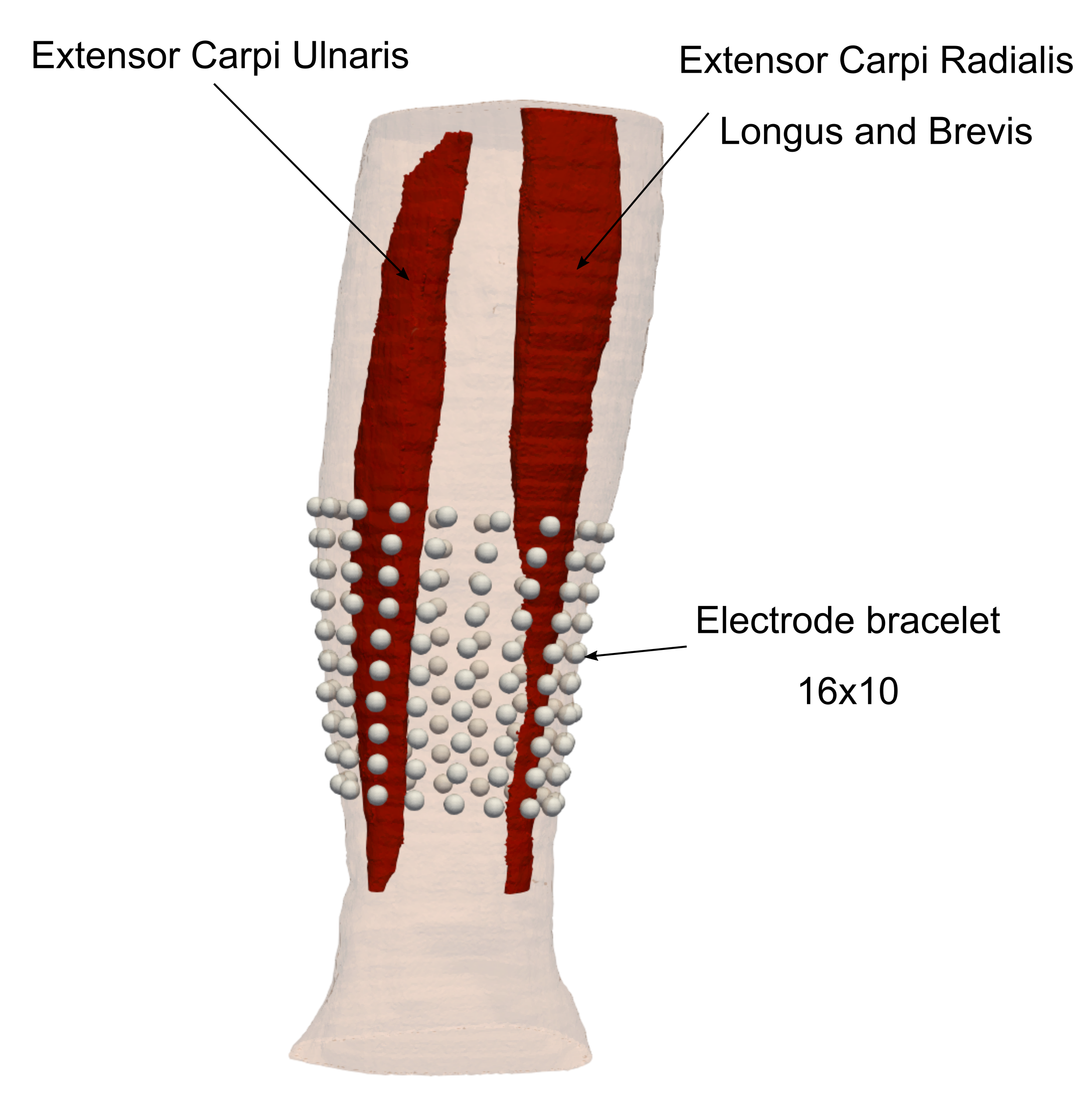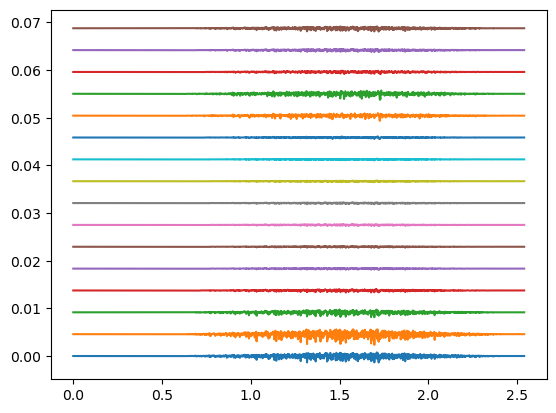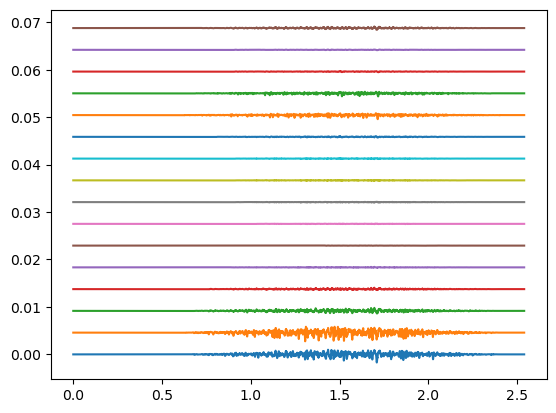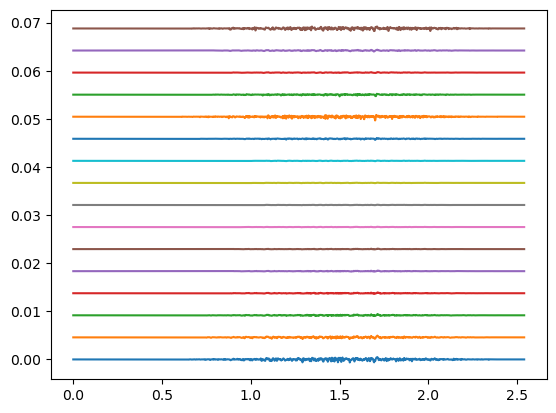Demo model from MRI#
This script builds a model from a segmented MRI for Subject_01.
The corresponding jupyter notebook script can be downloaded here.
The input data can be downloaded here.
Segmented MRI is stored in a “MRI Segmentation.nii.gz” file and is open with nibabel package.
The detailed label information is presented in “label_description.json” file. It contains tissue information for each image label as well as muscle information (human readable labels and tendon planes) for most of the muscles. This input is sufficient to build a full model.
%config Completer.use_jedi = False
import glob
import os
import json
from itertools import product
import time
import pickle
import matplotlib.pyplot as plt
import trimesh
import numpy as np
import nibabel as nib
import neurodec as nd
nd.mdt._API_URL = "http://18.205.41.67:8001/"
nd.mdt.wait = False # Set to true to wait step by step.
Prepare model#
Load MRI segmentation and labels information
DATA_DIR = '<your-data-path>/subject-01/'
nii = nib.load(DATA_DIR + 'MRI Segmentation.nii.gz')
image = nii.get_fdata()
voxel_sizes = np.array(nii.header.get_zooms()) * 1e-3 # from mm to m
with open(DATA_DIR + 'labels_description.json') as f:
labels_description = json.load(f)
# Only these labels will be taken into account to build volume conductor
labels_per_tissue = {
nd.mdt.TissueType.BONE: [ld['label_in_image'] for ld in labels_description['bones']],
nd.mdt.TissueType.MUSCLE: [ld['label_in_image'] for ld in labels_description['muscles']],
nd.mdt.TissueType.FAT: labels_description['fat']['label_in_image'],
nd.mdt.TissueType.SKIN: labels_description['skin']['label_in_image'],
}
# Ignore marker labels when building volume conductor. Defining this list is optional,
# but it prevents warning messages when creating Image object
labels_to_ignore = np.arange(23, 35)
Create image object
mri_image = nd.mdt.Image.new(image, voxel_sizes, labels_per_tissue, labels_to_ignore)
Create volume tetrahedral mesh from image
volume_mesh = nd.mdt.Tetrahedra.from_image(mri_image)
Create volume conductor
volume_conductor = nd.mdt.Conductor.new(volume_mesh)
Create electrode bracelet
outer_skin_surface = volume_mesh.skin
radius = 0.003 # in meters
first_electrode_location = np.array([0.048833, 0.039151, 0.225424])
rings_normal = np.array([-0.06736656677532368, 0.028649074948560272, -0.9973168885492202])
n_rings = 10
distance_between_rings = 0.009 # in meters
n_electrodes_per_ring = 16
bracelet = nd.mdt.ElectrodeBracelet.new(
outer_skin_surface, radius, first_electrode_location, rings_normal,
n_rings, distance_between_rings, n_electrodes_per_ring)
Generated electrodes can be saved as spheres for further visualization
for i, electrode in enumerate(bracelet.electrodes):
sphere = trimesh.creation.icosphere()
sphere.vertices = sphere.vertices * electrode.radius
sphere.vertices = sphere.vertices + electrode.location
sphere.export(DATA_DIR + f'electrodes/elec_{i}.stl')
Create forward solution
forward_solution = nd.mdt.ForwardSolution.new(volume_conductor, bracelet.electrodes)
Generate MUAPs for each muscle of interest#
Store muscle surfaces extracted from volume mesh with respect to their label in image
surfaces = {}
for surface in volume_mesh.muscles:
surfaces[surface.image_label] = surface
Generate fibers, motor units and MUAPs.
Note, that we don’t generate fibers for all the muscles in volume conductor. Anconeus and Brachioradialis are not fully contained within the forearm segment and Supinator has too complex geometry to efficiently extract fibers with our current approach. For these muscles we don’t provide tendon plane origins and normals in label description file.
SAMPLING_FREQUENCY = 4000
n_motor_units = 200
muscles_of_interest = []
muaps_per_muscle = []
for muscle in labels_description['muscles']:
# We are only interested in muscles for which tendon planes are defined
if 'plane_origins' in muscle:
# Get muscle surface
muscles_of_interest.append(muscle)
muscle_surface = surfaces[muscle['label_in_image']]
plane_origins = np.array(muscle['plane_origins'])
plane_normals = np.array(muscle['plane_normals'])
# Generate fibers
fibers = nd.mdt.Fibers.new(muscle_surface, plane_origins, plane_normals)
# Generate fiber basis
fiber_basis = nd.mdt.FiberBasis.new(fibers, forward_solution)
# Define fiber properties
fiber_properties = nd.mdt.FiberProperties.new(fibers)
# Generate motor units
motor_units = nd.mdt.MotorUnits.new(fibers, n_motor_units)
# Simulate corresponding muaps
muaps = nd.mdt.MotorUnitsActionPotentials.new(fibers, fiber_basis, fiber_properties, motor_units,
SAMPLING_FREQUENCY)
muaps_per_muscle.append(muaps)
Simulate simple movement#
def single_muscle_activation(max_mvc, duration, peak_time, fs):
n_time_samples = int((peak_time + duration / 2.) * fs)
t = np.linspace(-np.pi / 2, np.pi + np.pi / 2, int(duration * fs))
waveform = max_mvc * 0.5 * (np.sin(t) + 1.)
i_0 = n_time_samples - len(waveform)
muscle_activation = np.zeros(n_time_samples)
muscle_activation[i_0:] = waveform
return muscle_activation
def generate_movement(n_muscles, mean_max_mvc, std_max_mvc, duration, peak_time, fs):
muscle_activations = []
for i in range(n_muscles):
max_mvc = np.random.uniform(mean_max_mvc - std_max_mvc,
mean_max_mvc + std_max_mvc)
max_mvc = np.clip(max_mvc, 0., 100.)
muscle_activations.append(single_muscle_activation(max_mvc, duration, peak_time, fs))
return muscle_activations
Print labels of the muscles of interest
for i, muscle in enumerate(muscles_of_interest):
print(i, muscle['label'])
0 Extensor Carpi Ulnaris
1 Flexor Digitorium Profundus
2 Flexor Carpi Ulnaris
3 Extensor Digitorium
4 Extensor Digiti Minimi
5 Extersor Carpi radialis Longus AND Brevis
6 Palmaris Longus
7 Flexor Carpi Radialis
8 Flexor Digitorium Superficialis
9 Abductor Pollicis Longus
10 Extensor Indicis
11 Extensor Pollicis Longus
12 Pronator Teres
13 Flexor Policis Longus
14 Pronator Quadratus
Select wrist extensors
muscle_idx = [0, 5]

Generate a simple 2 second long muscle activation pattern corresponding to a wrist extension of around 40%MVC at its peak.
np.random.seed(1)
n_muscles = len(muscle_idx)
mean_max_mvc = 40 # %MVC
std_max_mvc = 10 # add some inter muscle variability in %MVC
duration = 2. # sec
peak_time = 1.5 # sec
activations = generate_movement(n_muscles, mean_max_mvc, std_max_mvc, duration, peak_time, SAMPLING_FREQUENCY)
for single_activation in activations:
times = np.arange(len(single_activation)) / SAMPLING_FREQUENCY
plt.plot(times, single_activation)

Generate impulse trains for each active muscle
impulse_trains_per_muscle = []
for muscle_id, single_activation in zip(muscle_idx, activations):
impulse_trains_per_muscle.append(nd.mdt.ImpulseTrains.new(muaps_per_muscle[muscle_id],
single_activation,
random_seed=0))
Assemble raw sEMG signal from muaps and impulse trains, and load the resulting data.
emg_per_muscle = []
for impulse_trains in impulse_trains_per_muscle:
emg = nd.mdt.Electromyography.new(impulse_trains)
emg.wait() # wait for the computation to finish before loading the EMG data
emg_per_muscle.append(emg.data.copy())
Sum up EMG signals of individual muscles
min_length = np.min([e.shape[1] for e in emg_per_muscle])
emg_total = np.sum([e[:, :min_length] for e in emg_per_muscle], axis=0)
Plot the results
times = np.arange(emg_total.shape[1]) / SAMPLING_FREQUENCY
plot_shift = np.ptp(emg_total)
rings_to_plot = [0, 4, 9]
for ring in rings_to_plot:
emg_to_plot = emg_total[ring*16:(ring+1)*16]
plt.figure()
plt.plot(times, emg_to_plot.T + plot_shift * np.arange(16))
plt.show()


